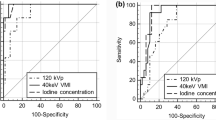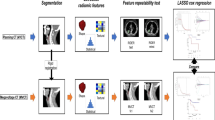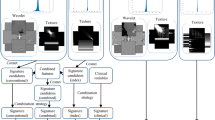Abstract
Purpose
To develop and validate a dual-energy CT (DECT)–based radiomics nomogram from multicenter trials for predicting the histological differentiation of head and neck squamous cell carcinoma (HNSCC).
Methods
A total of 178 patients (112 in the training and 66 in the validation cohorts) from eight institutions with histologically proven HNSCCs were included in this retrospective study. Radiomics-signature models were constructed from features extracted from virtual monoenergetic images (VMI) and iodine-based material decomposition images (IMDI), reconstructed from venous-phase DECT images. Clinical factors were also assessed to build a clinical model. Multivariate logistic regression analysis was used to develop a nomogram combining the radiomics signature models and clinical model for predicting poorly differentiated HNSCC and moderately well-differentiated HNSCC. The predictive performance of the clinical model, radiomics signature models, and nomogram was compared. The calibration degree of the nomogram was also assessed.
Results
The tumor location, VMI-signature, and IMDI-signature were associated with the degree of HNSCC differentiation, and areas under the ROC curves (AUCs) were 0.729, 0.890, and 0.833 in the training cohort and 0.627, 0.859, and 0.843 in the validation cohort, respectively. The nomogram incorporating tumor location and two radiomics-signature models yielded the best performance in training (AUC = 0.987) and validation (AUC = 0.968) cohorts with a good calibration degree.
Conclusion
The nomogram that integrated the DECT-based radiomics-signature models and tumor location showed good performance in predicting histological differentiation degree of HNSCC, providing a novel combination for predicting HNSCC differentiation.



Similar content being viewed by others
Availability of data and material
The datasets generated and/or analyzed during the current study are not publicly available but are available from the corresponding author on reasonable request. Data sharing is not applicable to this article as no datasets were generated or analyzed during the current study.
Code availability
All statistical analysis was conducted using an online R software (v.3.4.1; http://www.Rproject.org). ICC was calculated using “lme4” package. LASSO regression analysis was performed using the “glmnet” package. Multivariate logistic regression and nomogram construction were performed using the “rms” package. ROC curves were plotted using the “pROC” package. Calibration curve and Hosmer–Lemeshow test were conducted using the “ModelGood” package.
References
Johnson DE, Burtness B, Leemans CR, Lui V, Bauman JE, Grandis JR (2020) Head and neck squamous cell carcinoma. Nat Rev Dis Primers 6:92
Bray F, Ferlay J, Soerjomataram I, Siegel RL, Torre LA, Jemal A (2018) Global cancer statistics 2018: GLOBOCAN estimates of incidence and mortality worldwide for 36 cancers in 185 countries. CA Cancer J Clin 68:394–424
Anderson EM, Luu M, Balzer BL et al (2021) Variations in the association of grade with survival across the head and neck cancer landscape. Head Neck 43:1105–1115
Fortin A, Couture C, Doucet R, Albert M, Allard J, Tetu B (2001) Does histologic grade have a role in the management of head and neck cancers? J Clin Oncol 19:4107–4116
Losic B, Craig AJ, Villacorta-Martin C et al (2020) Intratumoral heterogeneity and clonal evolution in liver cancer. Nat Commun 11:291
Dong JX, Yan S, Xia S, Guo Y, Shen W (2019) Quantitative parameters correlated well with differentiation of squamous cell carcinoma at head and neck: a study of dynamic contrast-enhanced MRI. Acta Radiol 60:962–968
Gaddikeri S, Gaddikeri RS, Tailor T et al (2016) Dynamic contrast-enhanced MR imaging in head and neck cancer: techniques and clinical applications. AJNR Am J Neuroradiol 37:588–595
Guo R, Guo J, Zhang L et al (2020) CT-based radiomics features in the prediction of thyroid cartilage invasion from laryngeal and hypopharyngeal squamous cell carcinoma. Cancer Imaging 20:81
Wu W, Ye J, Wang Q, Luo J, Xu S (2019) CT-based radiomics signature for the preoperative discrimination between head and neck squamous cell carcinoma grades. Front Oncol 9:821
Lu W, Zhong L, Dong D et al (2019) Radiomic analysis for preoperative prediction of cervical lymph node metastasis in patients with papillary thyroid carcinoma. Eur J Radiol 118:231–238
Forghani R (2019) An update on advanced dual-energy CT for head and neck cancer imaging. Expert Rev Anticancer Ther 19:633–644
Zhou Y, Su G, Hu H et al (2020) Radiomics analysis of dual-energy CT-derived iodine maps for diagnosing metastatic cervical lymph nodes in patients with papillary thyroid cancer. Eur Radiol 30:6251–6262
Xiao G, Hu Y, Ren J et al (2021) MR imaging of thymomas: a combined radiomics nomogram to predict histologic subtypes. Eur Radiol 31:447–457
Chen Y, Chan ATC, Le Q, Blanchard P, Sun Y, Ma J (2019) Nasopharyngeal carcinoma. The Lancet 394:64–80
Lennartz S, Le Blanc M, Zopfs D et al (2019) Dual-energy CT-derived iodine maps: use in assessing pleural carcinomatosis. Radiology 290:796–804
Udare A, Walker D, Krishna S et al (2020) Characterization of clear cell renal cell carcinoma and other renal tumors: evaluation of dual-energy CT using material-specific iodine and fat imaging. Eur Radiol 30:2091–2102
Forghani R, Srinivasan A, Forghani B (2017) Advanced tissue characterization and texture analysis using dual-energy computed tomography. Neuroimag Clin N Am 27:533–546
Yaşar S, Voyvoda N, Voyvoda B, Özer T (2020) Using texture analysis as a predictive factor of subtype, grade and stage of renal cell carcinoma. Abdom Radiol 45:3821–3830
Choi Y, Nam Y, Jang J et al (2020) Prediction of human papillomavirus status and overall survival in patients with untreated oropharyngeal squamous cell carcinoma: development and validation of CT-based radiomics. AJNR Am J Neuroradiol 41:1897–1904
Kim H, Park CM, Kang CK, Yoon J, Chae KJ, Goo JM (2018) Effect of CT acquisition parameters on iodine density measurement at dual-layer spectral CT. AJR Am J Roentgenol 211:748–754
Park YW, Kim S, Ahn SS et al (2020) Magnetic resonance imaging-based 3-dimensional fractal dimension and lacunarity analyses may predict the meningioma grade. Eur Radiol 30:4615–4622
Zhang L, Song T, Meng Z et al (2020) Correlation between apparent diffusion coefficients and metabolic parameters in hypopharyngeal squamous cell carcinoma: a prospective study with integrated PET/MRI. Eur J Radiol 129:109070
Mu Y, Sa N, Yu L, Lu S, Wang H, Xu W (2014) Epithelial cell adhesion molecule is overexpressed in hypopharyngeal carcinoma and suppresses the metastasis and proliferation of the disease when downregulated. Oncol Lett 8:175–182
Acknowledgements
We would like to thank Dr. Zhoushe Zhao from GE Healthcare China for providing technical support regarding radiomics analysis. We also acknowledge Professor Vincent Chong at the National University of Singapore for the revision of this manuscript and language polishing.
Funding
This study was funded by the Beijing Municipal Administration of Hospitals’Ascent Plan (DFL20190203), Beijing Municipal Administration of Hospitals Clinical Medicine Development of Special Funding Support (ZYLX201704), and High Level Health Technical Personnel of Bureau of Health in Beijing (2014–2-005).
Author information
Authors and Affiliations
Contributions
Writing—original draft perparation: Zheng Li; writing—revising it critically: Zhaohui Liu; methodology: Yan Guo and Sicong Wang; acquisition of data: Xiaoxia Qu, Yajun Li, Yucheng Pan, Longjiang Zhang, Danke Su, Qian Yang, Xiaofeng Tao, and Qiang Yue; agreement to be accountable for all aspects of the work in ensuring that questions related to the accuracy or integrity of any part of the work are appropriately investigated and resolved: Junfang Xian.
Corresponding author
Ethics declarations
Conflict of interest
The author(s) declared no potential conflicts of interest with respect to the research, authorship, and/or publication of this article.
Ethics approval
All procedures performed in the study were approved by institutional review board in accordance with the ethical standards and with the 1964 Helsinki declaration and its later amendments or comparable ethical standards.
Consent to participate
Written informed consent was waived because of the retrospective nature of the study.
Consent for publication
Written informed consent for publication was obtained from all participants.
Additional information
Publisher's note
Springer Nature remains neutral with regard to jurisdictional claims in published maps and institutional affiliations.
Supplementary Information
Below is the link to the electronic supplementary material.
Rights and permissions
About this article
Cite this article
Li, Z., Liu, Z., Guo, Y. et al. Dual-energy CT-based radiomics nomogram in predicting histological differentiation of head and neck squamous carcinoma: a multicenter study. Neuroradiology 64, 361–369 (2022). https://doi.org/10.1007/s00234-021-02860-2
Received:
Accepted:
Published:
Issue Date:
DOI: https://doi.org/10.1007/s00234-021-02860-2




